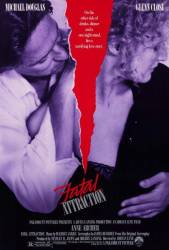Trivia: The opera that Glenn Close buys the tickets for is Madame Butterfly. That is the song she is listening to when we see the first signs that she is losing it. Note: At the end of Madame Butterfly the heroine kills herself over a lover. In the director's cut of Fatal Attraction Glenn Close cuts her throat in the bathroom of Michael Douglas' house thereby killing herself over a lover.
Trivia: In the cocktail party scene, there is a quick shot of the large crowd attending the party. Look closely at the dark-haired man near the front of the party goers - it's James Eckhouse, who played Mr. Walsh on "Beverly Hills 90210" He also had a similar, uncredited role as an 'extra' in the first bar scene in the movie "Cocktail."
Trivia: The original ending had Alex Forrest committing suicide with Dan Gallagher arrested for her death.
Trivia: After Alex takes Dan's daughter for an hour or two, and Beth has a car accident, as she frantically searches for her daughter, Dan rushes over to Alex's place to kill her, but he has enough sense not to, and, in a Hitchcock way, the camera zooms in on a very large knife that Dan puts down on a ledge, with know-it-alls yelling, "It has your fingerprints on it," he walks away. The original ending had Alex killing herself with the knife that has Dan's fingerprints on it and Dan going to jail for Alex's murder. When they showed this version to a test group, all of them yelled and screamed so much that they had to change the ending.
Trivia: There is no music for the first half-hour of the movie.






Answer: Because she is insane! And she picked the lock. By murdering the innocent pet bunny rabbit Alex was sending a message. She won't be ignored! She's just letting Dan know that she can get to him, or in this case his family (daughter's pet), anytime she wants to. He's not safe.
Alan Keddie